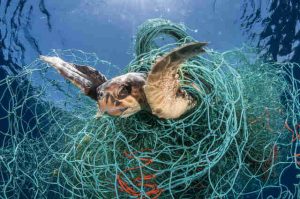 ©CURADAS
©CURADAS
Un grupo de investigadores de la Universidad de Exeter (Inglaterra) han desarrollado un método que permite reducir las capturas accesorias de animales marinos en un 70% de media. La comunidad de científicos espera que este método sirva de estímulo positivo para la pesca sostenible.
Las redes de enmalle o “agalleras” son paredes de tela vertical que, mediante pesos o ancla, se mantiene calada al fondo marino. Debido a su coste de construcción y facilidad de uso, se trata de un método muy utilizado en las pesquerías artesanales.
Sin embargo, una de las grandes desventajas es que atrapan animales marinos no deseados (descartes), desfavoreciendo los ecosistemas marinos, especialmente a la fauna como tortugas, aves marinas y cetáceos.
El método desarrollado por los investigadores se basa en colocar luces LED a lo largo de las redes que podría reducir las capturas no deseadas hasta en un 70%. Este estudio fue recientemente publicado en la revista Science, basada en un estudio anterior en el que se hacía hincapié en el impacto de este método de pesca sobre la fauna marina.
Alessandra Bielli, científica del Centro de Ecología y Conservación y autora principal del estudio, explicó a National Geographic España que, en ensayos anteriores se habían empleado otro tipo de técnicas, como las luces ultravioleta, las señales químicas o los paneles de alarma acústicas. Sin embargo, este método podría ayudar a salvar tortugas marinas en cualquier parte del mundo, desde el Golfo de México hasta el Mediterráneo.
En la metodología de investigación, los científicos usaron diodos LED en las boyas que sujetan 864 redes de pesca desplegadas en pequeñas embarcaciones cerca de tres puertos peruanos, recabando datos entre 2015 y 2018. La conclusión a la que llegaron tras analizar la información recibida, fue que las redes iluminadas habían capturado un 74.4% menos de tortugas marinas y un 70.8% menos de pequeños cetáceos que las no iluminadas. A su vez, la presencia de luces LED también redujo en un 85% el número de aves marinas capturadas.
Este sistema ha demostrado lo simple y barato que puede ser proteger a la fauna amenazada, ya que puede utilizarse en cualquier lugar y con todo tipo de redes de pesca.
__
LED LIGHTS TO SAVE MARINE WILDLIFE
A group of researchers at the University of Exeter (England) have developed a method to reduce bycatch of marine animals by an average of 70%. The scientific community hopes that this method will serve as a positive stimulus for sustainable fishing.
Gill nets or “gill nets” are vertical fabric walls that, by means of weights or anchors, are kept anchored to the seabed. Due to its cost of construction and ease of use, it is a method widely used in artisanal fisheries.
However, one of the great disadvantages is that they trap unwanted marine animals (discards), harming marine ecosystems, especially fauna such as turtles, seabirds and cetaceans.
The method developed by the researchers is based on placing LED lights along the nets that could reduce unwanted catches by up to 70%. This study was recently published in the journal Science, based on a previous study that emphasized the impact of this fishing method on marine fauna.
Alessandra Bielli, a scientist at the Center for Ecology and Conservation and lead author of the study, explained to National Geographic Spain that previous trials had used other types of techniques, such as ultraviolet lights, chemical signals or acoustic alarm panels. However, this method could help save sea turtles anywhere in the world, from the Gulf of Mexico to the Mediterranean.
In the research methodology, the scientists used LED diodes on buoys holding 864 fishing nets deployed on small boats near three Peruvian ports, collecting data between 2015 and 2018. The conclusion they reached after analyzing the information received was that the illuminated nets had captured 74.4% fewer sea turtles and 70.8% fewer small cetaceans than those that were not illuminated. In turn, the presence of LED lights also reduced the number of seabirds caught by 85%.
This system has shown how simple and inexpensive it can be to protect endangered wildlife, as it can be used anywhere and with all types of fishing nets.
__

